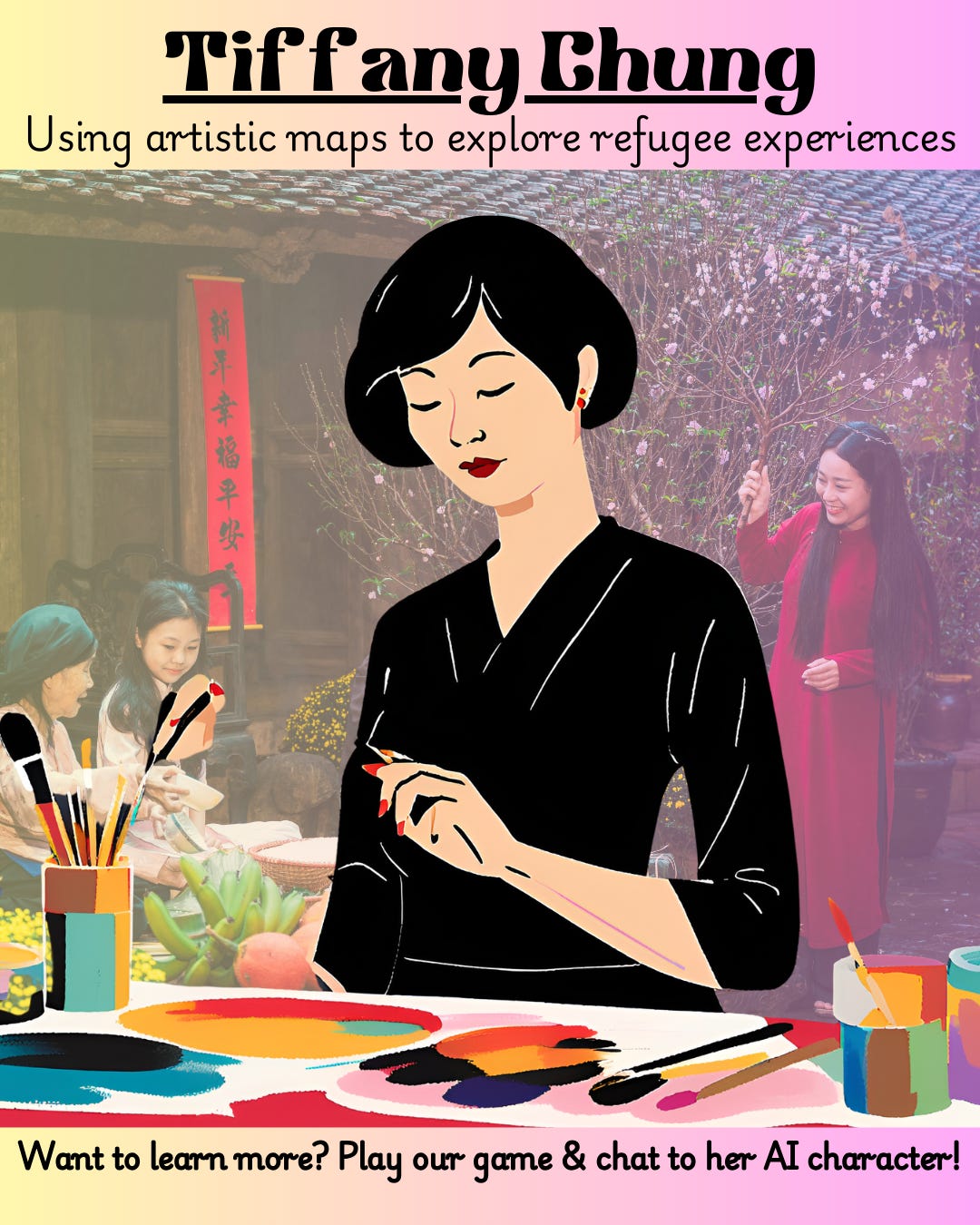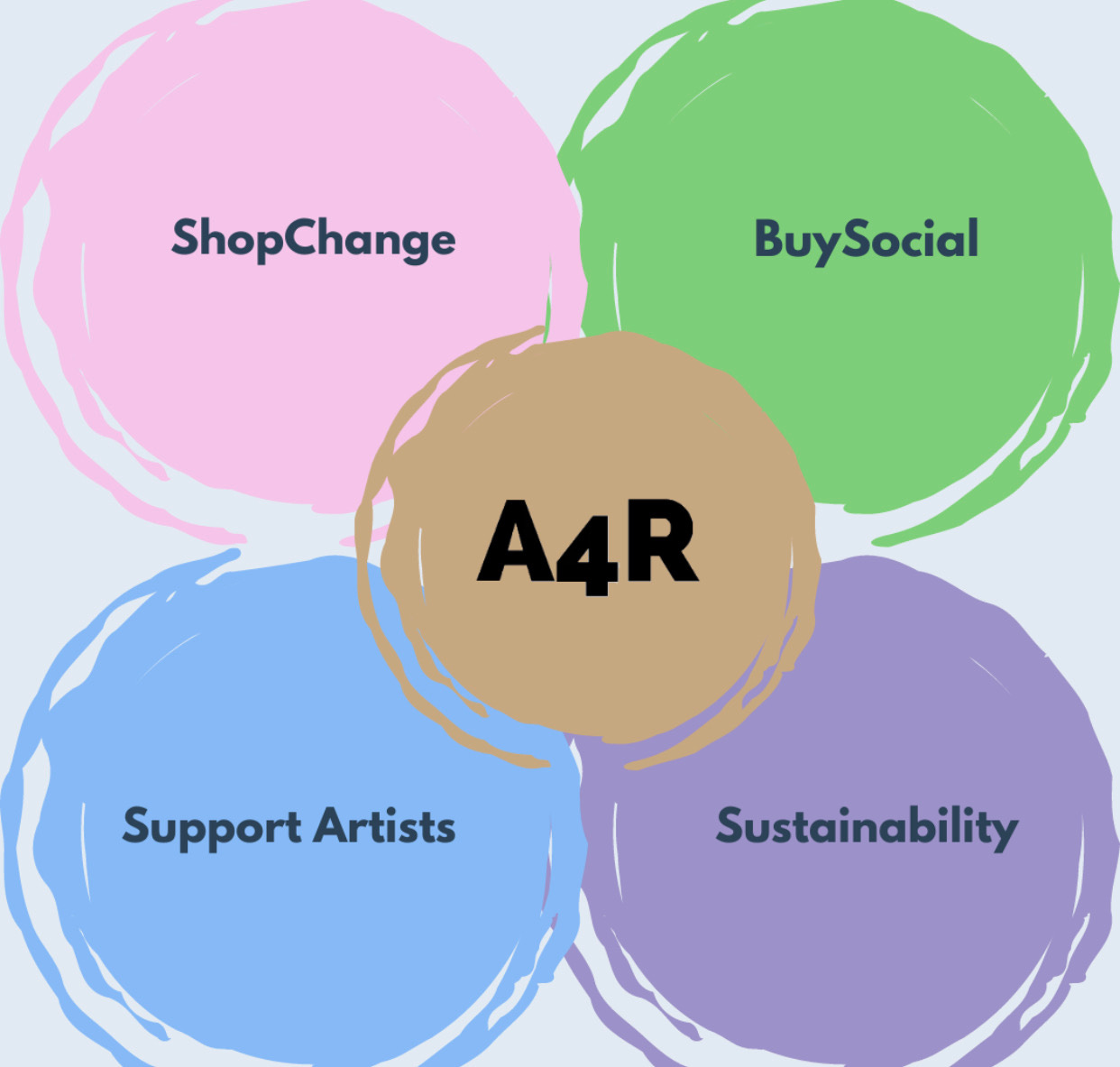Hidden Histories, Powerful Maps: She Turns War's Scars into Art You Can't Ignore. 🗺️💔
Read, Listen, Play & learn about Tiffany Chung's arty refugee experience 🎮
Click here to play & learn.
Back Story
Tiffany Chung: Visual Artist Mapping the Impacts of Conflict and Displacement
Tiffany Chung is an inspirational visual artist. She has used her work to highlight the devastating impact of natural and human crises on local people. Drawing from her personal experiences and deep research, Tiffany aims to unveil the realities faced by refugees and trace the journeys of displaced communities.
Background
Tiffany Chung was born in 1969 in Da Nang, Vietnam, where her childhood was shaped by the ongoing Vietnam War. Vietnam had been in conflict since gaining independence from France in 1954. This resulted in the country being divided into Communist-controlled North Vietnam and US-supported South Vietnam.Tiffany was born at a time where the war had escalated from guerrilla warfare to direct US military involvement against communist insurgents. While this tore communities apart and led to acute instability, the conflict had a deeper meaning for Tiffany. Her father fought for South Vietnam as a helicopter pilot. Some of her work does have a connection to her father’s experiences, such as Operation Lam Son 719 in 1971 (2015), in which the airport marked is one her father frequently visited.
After the Fall of Saigon in 1975, hundreds of thousands of Vietnamese people, for reasons ranging from their fear of the new Communist regime to being displaced as a result of the fighting, fled the country as refugees. There is now a large Vietnamese diaspora, estimated in 2023 to be 5-6 million (Huynh, 2023). Tiffany’s family, because of her father’s role in the conflict, fled Vietnam as refugees and settled in the United States of America. Tiffany’s personal experiences have played a crucial role in not just the themes she chooses to explore, but also in her art itself.
Tiffany went on to get a Bachelor of Fine Arts in Photography from California State University and a Master of Fine Arts in Studio Art from the University of California. After this, she followed the trend of many young Vietnamese at the time returning to the country from the early 2000s. Tiffany was based in Ho Chi Minh City from 2000-2017, where she explored her own art as well as supporting other artists.
Return to Vietnam: Discovering Cartography as a Form of Art
One notable achievement of Tiffany’s while in Vietnam was co-founding the Sàn Art organisation. This grassroots initiative has collaborated with local and international artists to elevate their work and expose it to wider audiences. They help in hosting exhibitions, as well as regular educational programs. While Tiffany has since returned to the US, it remains a leading group in Vietnam and the wider region. It is now looking to expand as a community hub to support innovative practices and perspectives.
It was also in Vietnam where Tiffany uncovered what would become her most recognisable art form: cartography. As a visual artist, she produces paintings, sculptures, performances, and many other forms of visual art. However, working with maps remains Tiffany’s most unique way of expressing her art. She has stated in interviews that she views cartography as “the role of God in forming a community, a society, a nation-state” (Tiffany Chung: Artist Profile, 2022). Because of this, Tiffany has aimed to subvert power and authority by using maps, and remapping, to explore her themes.
Thematic Cartography & Mapping Trauma
Focusing on cartography, Tiffany has been very mindful in terms of how and why she creates her maps. Reconstructing an Exodus History: Flight routes from camps and ODP cases (2019) is an example of this. A world map centered on Asia, Tiffany traced the destinations of Vietnamese migrants through flight paths, from refugee camps beyond Vietnam to across the globe. In doing so, she connected the Vietnamese diaspora, linking them to communities across the world. Tiffany’s Vietnamese influence can also be seen in how the art itself was crafted. She specifically embroidered the map, according to a wartime tradition among Vietnamese women. In villages, the women would often come together in groups to do embroidery. It was their way of passing the time, waiting for their loved ones to come home. By choosing to embroide the piece, Tiffany acknowledged the impact that conflict had on the migration patterns of many Vietnamese people, and how conflict has been ingrained into their collective consciousness. It is also possible that this was something Tiffany was exposed to as a child in Vietnam, as her father was often away from her & her mother.
The consequence of war in displacing communities and migration make up just some of the topics that Tiffany Chung has explored in her art throughout her career. Another is collective, cultural memory, a theme which is embedded in Reconstructing an Exodus History. Tiffany has been praised for the interdisciplinary approach she has taken to her work, often conducting her own research and interviews as part of her art process. In doing so, she ensures that her work reflects the lived experiences of those who the work represents. By engaging directly with people and their experiences, Tiffany also bypasses established narratives. This gives room for her work to challenge established views, providing a new insight.
Tiffany’s work with cartography also allows her to explore landscapes and how they have changed over time. This is how her cartography work started, mapping out the landscape of a village on the outskirts of Ho Chi Minh City. Specifically, she has been exploring the effects of urban development. Some of her work has overlapped maps from different periods to convey change over time, other creating maps from a cultural or social perspective. This has been complemented by some of her other endeavors, such as archaeology. Through her excavation work in Thủ Thiêm, she unearthed everyday artifacts such as children’s shoes and tiles. While by themselves they were mute objects,together with her cartography it invited audiences to consider the colonial history and transformation of the area.
Tiffany's exploration of cartography as an artistic medium also connects to a broader criticism of imperialism. Tiffany holds that cartography is a powerful tool in creating communities and societies. However, many communities were divided as part of colonial mapmaking, such as the 1884-85 Berlin Conference, which resulted in the carving up of Africa by European imperial powers. Vietnam itself was a French colony, only gaining independence after a bloody war with France, lasting from 1946 to 1954. Even afterwards, Vietnam was split into two, only becoming unified after the Vietnam War. Many of these colonial-era borders exist to this day, and the social tensions they created have continued to incite conflict and displace people. Part of Tiffany’s work with maps is to reclaim this power, aided by her experiences with refugees. Ultimately, Tiffany’s work serves as a powerful reminder of the need to confront and heal the divisions created by the colonial past.
Academic Work and Awards
Tiffany Chung's interdisciplinary approach to her art has also led her to make significant contributions beyond the gallery walls. In addition to her visually striking cartographic works, she has written extensively on topics of conflict, displacement, and climate change, engaging in both academic and political discourses. Her pioneering research has been utilised across disciplines, from urban studies to refugee and memory studies. Chung's expertise and unique perspective have been widely recognised, including her receipt of the Asia Arts Game Changer Award in 2020 and prestigious academic fellowships such as the Jane Lombard Fellowship for Art & Social Justice (2018-2020) and Mellon Arts & Practitioner Fellowship at Yale's Center for the Study of Race, Indigeneity, and Transnational Migration (2021). Most recently, Chung was named an inaugural fellow of the KAVAH Fermata Fellowship at the University of Chicago, further cementing her status as a leading scholar and practitioner whose work bridges the divide between academic inquiry and creative expression.
Summary
Tiffany Chung has dedicated her life to exploring the effects of conflict, migration, and displacement. Her focus on the communities impacted by these forces allows her work to serve as a powerful vessel for collective memory, ensuring that the stories of those affected are not lost to history. Through her innovative use of cartography and interdisciplinary research, she challenges dominant narratives by offering alternative perspectives on war, migration, and urban transformation. In reclaiming the tools of power—maps and historical records—Chung not only documents the past but also reimagines a future where displaced voices are acknowledged and histories are remembered. Her work stands as both an artistic and academic contribution, demonstrating the power of art in confronting the consequences of imperialism, displacement, and change.
Bibliography
Huynh, Jennifer (2023-11-01). "The Border Within: Vietnamese Migrants Transforming Ethnic Nationalism in Berlin". Contemporary Sociology. 52 (6). pp. 582–584
Tiffany Chung: Artist Profile (2022) accessed via
“Biography” accessed via https://www.tiffanychung.net/biography
“About” accessed via https://san-art.co/info/about/
“Tiffany Chung: Re-mapping Memories of the Vietnam War” accessed via https://scma.smith.edu/blog/tiffany-chung-re-mapping-memories-vietnam-war
Reconstructing an Exodus History: Flight routes from camps and ODP cases (2019)https://americanart.si.edu/artwork/reconstructing-exodus-history-boat-trajectories-vietnam-and-flight-routes-refugee-camps-and
In this post Tyler highlights the arty refugee experience of Tiffany Chung. He is a citizen journalist on a placement with us organised by Oxford University Career Services. He also organised the micro game to make the journalistic experience interactive.
Thank you for reading an A4R 🎨 Post. Don’t forget to visit our gift shop here. Every purchase scales our impact and pays our bills.





